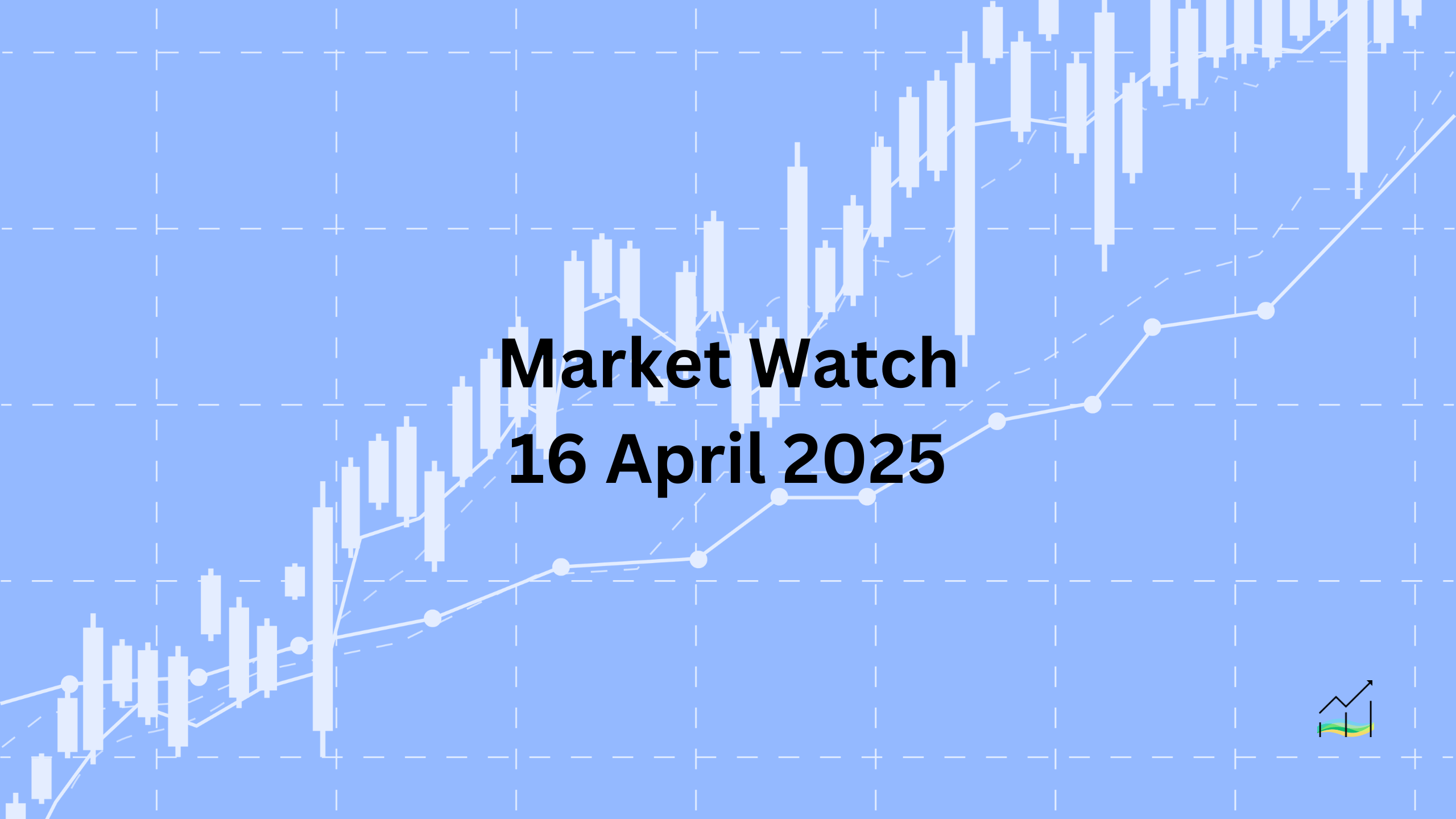16/04/2025 Market Watch

Trade Tensions Flare, Safe Havens Gain Ground
Key Takeaways:
- Trade tensions resurface after fresh US-China tech and aviation restrictions.
- Swiss franc continues to outperform, while the dollar slips broadly.
- Asia and Europe equities turn red; US futures also under pressure.
- Gold hits a new record; oil firms up after early dip.
- China’s Q1 growth surprises to the upside, but skepticism remains.
Market sentiment soured once again as geopolitical and trade tensions between the US and China flared up. The brief calm earlier this week was disrupted after Beijing took action against Boeing and the US imposed new export license requirements on Nvidia’s H20 chip, which was designed to meet prior restrictions. Adding to concerns, weak results and a disappointing order book from ASML raised fresh questions about the global tech outlook.
Despite the US highlighting progress with countries seeking tariff relief, the EU maintained a pessimistic tone about the trajectory of trade negotiations. Meanwhile, comments from the Bank of Japan's Governor Ueda hinted at possible downward revisions to Japan's growth forecast due to persistent economic shocks.
Currency markets reflect this cautious mood. The dollar is broadly weaker, with the Swiss franc leading G10 gains. Emerging market currencies are also firmer, including the Chinese yuan, as markets reacted to China’s stronger-than-expected Q1 growth, though many analysts remain skeptical about the reliability of the data.
Equities are feeling the pressure. Asia-Pacific markets and Europe’s Stoxx 600 both declined for the first time this week, and US index futures are down, especially the Nasdaq, which is trading below last week’s closing levels.
In the bond space, yields are mostly lower. Japan’s 10-year yield dropped by nearly 10 basis points, while European benchmark yields slipped by 1–2 bps. UK Gilts outperformed after a softer-than-expected CPI print, while Swiss yields dropped almost four basis points, reflecting safe haven demand. US Treasury yields remain steady near 4.34%, well below last week’s 4.60% peak.
Commodities show a contrasting tone. Gold surged to a fresh record near $3318, supported by risk aversion. Oil prices remained firm, with June WTI recovering from an early dip to trade close to yesterday’s high around $61.60.
United States of America
Overview
The market's focus has shifted back to real-sector data as attention turns to March retail sales and industrial production figures. Although the dollar is retreating from yesterday's gains, the broader trend remains intact within last Friday's range. Fed Chair Powell is also scheduled to speak, though significant surprises are not expected. Markets continue to interpret incoming data in the context of trade uncertainty and recent consumer behavior shifts.
Economic Drivers
- Retail sales expected to be supported by early auto purchases ahead of expected tariffs
- Retail control group (excluding auto, gas, building materials, food services) forecast to rise 0.6% in March vs. 1.0% in February
- Inflation-adjusted PCE showed weakness in Q1: -0.6% in January and +0.1% in February
- Industrial production forecast to decline 0.2% in March after a 2% gain over the prior three months
- Manufacturing output expected to rise 0.2% after gains of 0.1% (Jan) and 0.9% (Feb)
- Manufacturing employment rose by 4k in Q1 2025, after a 40k drop in Q4 2024
- Fed Chair Powell expected to maintain a patient stance, citing softness in survey data but strength in hard data
Data and Events
- 16 April 2025 – March Retail Sales: Headline and control group figures watched for tariff-related front-loading effects
- 16 April 2025 – March Industrial Production: Forecast to dip slightly, with focus on manufacturing output
- 16 April 2025 – Fed Chair Powell Speech: At Economic Club of Chicago, 1:30 PM ET
- 16 April 2025 – February TIC Portfolio Flows: Late-session release; unlikely to impact market but monitored for capital flow trends
Price Action
- Dollar Index retreats but stays within Friday’s key range of 99.00–100.75
- Resistance near 100.75 also marks the 38.2% retracement from April’s high (~103.55)
- Real sector data and Powell’s comments may influence near-term direction, but technical structure remains dominant
Key Points:
- Dollar remains range-bound despite today’s pullback
- Retail and industrial data offer insight into real-sector strength
- Powell likely to reiterate patient approach amid mixed signals
- February capital flows data not expected to shift sentiment
Australia
Overview
The Australian dollar has rebounded sharply from last week’s five-year low, gaining around 8% against the US dollar. As it approaches the upper end of its multi-month range near $0.6400, profit-taking emerged. Markets are eyeing upcoming labour data and the sizeable option expiry today, while the latest RBA minutes suggest that weak job numbers are unlikely to prevent a rate cut next month.
Economic Drivers
- Australian dollar rallied 8% from five-year low ($0.5915) hit last Wednesday
- RBA minutes show a low bar for a rate cut next month
- Labour market data from February showed a loss of nearly 53k jobs, offsetting January’s 30.5k gain
- March unemployment rate expected to rise to 4.2%, matching the cyclical high seen last July
- Participation rate expected to dip slightly from July’s 67.0% level
Data and Events
- 17 April 2025 – March Employment Data: Key release expected to show weaker labour market conditions
- 16 April 2025 – A$2.35 bln Options Expiry at $0.6400: Expiry could influence intraday volatility
Price Action
- AUD/USD tested upper boundary of range established since mid-December
- $0.6400 is acting as near-term resistance with signs of profit-taking
- Options expiry at $0.6400 may contribute to price sensitivity at that level
Key Points:
- AUD rebounds sharply but hits resistance near $0.6400
- RBA minutes show policymakers are open to rate cuts
- March jobs data unlikely to derail easing path
- Option expiry adds to near-term technical tension
Canada
Overview
The Canadian dollar has seen choppy movement this week as the greenback snapped a four-day decline. While political and economic factors continue to weigh on sentiment, today's focus is on rate expectations and the CAD1.40 level, where notable option expiry adds technical significance. Despite upcoming federal elections, markets still price in a moderate chance of a rate cut, with attention shifting toward the June BoC meeting.
Economic Drivers
- Swaps market still pricing a ~40% chance of a rate cut today, despite upcoming election
- March jobs data showed back-to-back full-time job losses for the first time since Aug–Sept 2022
- Headline CPI eased to 2.3% from 2.6%; core inflation (2.8%–2.9%) back to Q2 2024 levels
- Canadian dollar strength adds pressure on exports and rate outlook
- Prime Minister Carney revoked last week’s 25% retaliatory tariffs on US-made cars, conditioned on continued local production and investment
Data and Events
- 16 April 2025 – Bank of Canada Rate Decision: Markets see ~40% chance of a cut; election seen as a limiting factor
- 16 April 2025 – USD/CAD $700 mln Options Expiry at CAD1.4000
- 4 June 2025 – Next Bank of Canada Meeting: Swaps market pricing ~80% chance of rate cut
Price Action
- USD/CAD faced resistance near the CAD1.40 level, turned lower toward CAD1.39
- Option expiry at CAD1.4000 today may cap further upside in the near term
- Recent strength in CAD reflects cautious positioning ahead of the election and rate expectations
Key Points:
- USD/CAD rejected from CAD1.40 amid option expiry pressure
- Rate cut odds for today remain modest, but June is more likely
- Weak jobs and CPI data support a dovish bias
- Political considerations limit BoC's flexibility in near term
China
Overview
The yuan is stabilising after recent volatility driven by renewed trade tensions and speculation over potential currency devaluation. Despite theories that China might sharply weaken the yuan to counteract US tariffs, the central bank appears to be gradually introducing more flexibility in the daily fix rather than pursuing abrupt moves. Meanwhile, Q1 GDP data slightly outperformed expectations, though the property sector remains under pressure. Fiscal and monetary easing is widely expected as Beijing seeks to shield domestic growth from external shocks.
Economic Drivers
- Despite trade war concerns, authorities appear committed to maintaining broad exchange rate stability against the US dollar
- Yuan has weakened to its lowest level against the euro since 2014, and near two-year lows against the yen
- Q1 2025 GDP: +1.2% QoQ and +5.4% YoY, slightly better than expected
- March data showed firmer retail sales and industrial production
- Property sector remains a drag: investment still contracting, prices continue falling (no monthly increase since May 2023)
- Surveyed urban unemployment fell to 5.2% in March from 5.4%, first improvement since October
- Economists continue to downgrade China’s growth outlook due to trade war impact
- PBOC expected to lower rates and reserve requirements; Beijing may increase fiscal stimulus
Data and Events
- 16 April 2025 – Daily CNY Fix: Set at CNY7.2133, showing increased PBOC flexibility
- Already Released – Q1 GDP: 1.2% QoQ, 5.4% YoY
- Already Released – March Data: Retail sales and industrial output slightly stronger; unemployment improves
Price Action
- USD/CNH rebounded to ~7.3260 yesterday but eased to 7.3120 today
- Support seen near yesterday’s low (~7.3075)
- Market remains sensitive to PBOC fix levels and US tariff developments
- Offshore yuan pressured by weak sentiment and trade concerns despite PBOC maintaining control
Key Points:
- No sharp devaluation by China despite tariff pressure
- PBOC gradually introducing more flexibility in daily fix
- Q1 GDP and March activity data slightly stronger, but property sector still weak
- Fiscal and monetary easing expected to continue to offset trade war impact
Europe
Overview
The euro is holding within a familiar range ahead of the highly anticipated ECB meeting. While it has rebounded from recent lows, it remains below the $1.1400 handle. A strong current account surplus, combined with a firm euro, weaker energy costs, and US tariff headwinds, have intensified expectations of ECB rate cuts. Meanwhile, EU officials have signaled that trade negotiations with the US are making little progress, and most tariffs are expected to remain in place for now.
Economic Drivers
- Eurozone February current account surplus: €34.3 billion
- Jan–Feb 2025 surplus totals €75.7 billion vs. €80 billion in same period 2024 and €18 billion in 2023
- Stronger euro, weaker oil, and US tariffs (currently at 10%, up from 2.5% end-2024) are seen weighing on growth
- Markets expect three ECB cuts this year, with about 40% odds of a fourth
- This week’s expected cut would lower deposit rate to 2.25%
- Market sees terminal ECB rate between 1.50% and 1.75%
- EU reports limited progress in trade negotiations with US; most US tariffs on EU likely to stay
Data and Events
- 17 April 2025 – ECB Policy Meeting: Market expects a rate cut to 2.25%
- Already Released – February Current Account: €34.3 billion surplus
Price Action
- EUR/USD bounced from ~1.1265 but remains capped below $1.1400
- Range-bound since last Friday, with key levels at $1.1190 and $1.1475
- Expectations of dovish ECB policy continue to weigh on upside potential
Key Points:
- Eurozone posts solid current account surplus but outlook clouded by tariffs
- ECB widely expected to cut rates this week
- Markets price in three cuts this year, possibly four
- Little progress in EU-US trade talks; tariffs likely to stay elevated
- EUR/USD remains range-bound ahead of ECB decision
Japan
Overview
Despite a notable drop in US yields, the yen failed to strengthen meaningfully, with the dollar holding near JPY142. Market sentiment remains cautious as traders weigh potential downward revisions to Japan’s growth forecasts due to the impact of US tariffs. Comments from BOJ Governor Ueda have added to this expectation. Japan’s March trade data is due tomorrow, with analysts watching for signs that recent export strength—especially to the US—may have been front-loaded ahead of tariff implementation.
Economic Drivers
- US 10-year yield dropped nearly 30 bps from recent highs, but USD/JPY held firm
- BOJ Governor Ueda’s comments suggest possible growth forecast revisions due to trade shock
- US tariffs have led to inventory build-ups by Japanese firms in the US
- February export surge (+11.4%) likely boosted by pre-tariff shipments, especially autos
- Japan’s trade surplus with the US in February was nearly JPY920 billion (~$6 billion), up ~30% YoY
- Japan hasn’t posted an annual trade surplus since 2020, despite periodic strong monthly figures
Data and Events
- 17 April 2025 – March Trade Balance: Expected to slightly deteriorate from February’s JPY590.5 billion surplus
- Already Released – BOJ Commentary: Caution on growth outlook tied to external shocks (e.g., tariffs)
Price Action
- USD/JPY tested JPY142.00 again today after holding firm since late last week
- Resistance seen in the JPY143.00–143.20 zone
- Despite falling US yields, yen remains weak, showing limited sensitivity to rate differentials currently
Key Points:
- USD/JPY holds steady near JPY142 despite lower US yields
- BOJ may cut growth outlook due to tariff-related risks
- March trade data expected to show mild softening, but export strength to US remains in focus
- Japan’s annual trade position still negative since 2020
- Technical resistance at JPY143.00–20 could cap further upside
United Kingdom
Overview
Sterling has shown resilience against the dollar, outperforming the euro in recent sessions. While a retreat in EUR/GBP has supported the pound, today’s softer inflation data weighed slightly on the cross. Still, broad dollar weakness allowed sterling to extend its rally for a seventh straight day, approaching the $1.33 level. Market expectations for multiple rate cuts this year remain intact despite inflation cooling at a gradual pace.
Economic Drivers
- March CPI rose 0.3%, putting Q1 inflation at 2.4% annualised (same as Q1 2024)
- Headline YoY CPI eased to 2.6% from 2.8%, due to base effects
- Core CPI slowed to 3.4% from 3.5%, and services inflation dipped to 4.7% from 5.0%
- Swaps market still pricing in a 25 bps cut in May and at least two more cuts by year-end
Data and Events
- 16 April 2025 – March CPI: Headline and core inflation cooled, aligning with rate cut expectations
- Upcoming – May 2025 BoE Meeting: Market fully pricing a 25 bps rate cut
Price Action
- GBP/USD approaching $1.33, extending gains for seventh consecutive session
- Closed above upper Band (~$1.3250) for two sessions, could do so again today
- EUR/GBP weakness contributed to sterling’s recent strength
Key Points:
- Sterling supported by EUR/GBP pullback and broad dollar softness
- Inflation slowed but remains sticky in services and core components
- Markets still expect at least three BoE rate cuts this year
© 2025 SKONE Enterprise (003319453-V). All rights reserved.
The content on this site is for informational purposes only and does not constitute financial advice.


